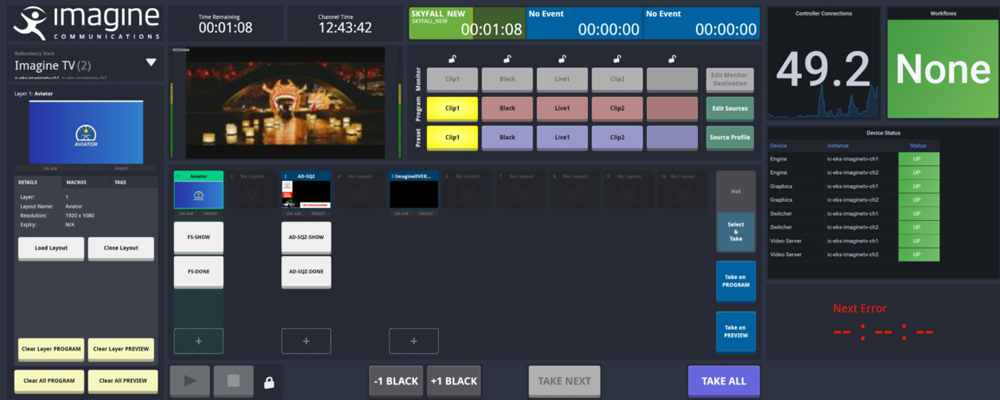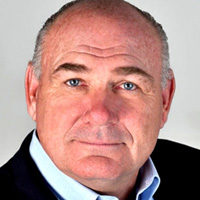
Broadcasters Weigh New Playout Options

Many broadcasters streamlined master control functions for their traditional linear businesses years ago by consolidating playout and traffic functions in network operations centers, or in the case of some large station groups, “hubbing” them at an individual station or third-party data center. Such moves allowed them to leverage centralized hardware and personnel across multiple channels and thereby reduce their overall technology investment and labor costs.
But as they look to fully exploit multiplatform delivery with the creation of new over-the-top (OTT) channels, networks and stations are increasingly turning to the cloud as a playout solution. And both traditional vendors and new players are meeting them with software-based solutions for program origination and advertising delivery, often sold on a subscription basis.
Imagine’s Reach To The Cloud
One of the longest-standing players in traditional master control automation is Imagine Communications, whose ADC-100 automation system (first created by Louth Automation) has been used for decades to control channel playout, starting with analog tape-based cart machines. The core ADC product is still being used to control video server playback at modern facilities, such as the 25,000-square foot IP-based Media Operations Center that Sinclair Broadcast Group built last year at Encompass Digital Media’s headquarters in Atlanta to handle origination of its regional sports networks.

Steve Reynolds
But Imagine has also been steadily developing software to control playout in the public cloud, and at NAB 2022 was highlighting Aviator, a new product aimed squarely at that market. Imagine Communications President Steve Reynolds described Aviator as a “orchestration console for planning, making and monetizing content” across multiple platforms using the Amazon Web Services cloud.
Aviator ties together several capabilities that were already in the Imagine portfolio, such as rights management and digital ad insertion, and is designed to support both traditional linear and OTT channel origination from a single unified system.
The “planning” piece of Aviator includes media plans, rights management and setting up ad inventory across multiple platforms, Reynolds said. The “make” piece for linear means channel origination, creating a transport stream suitable for traditional distribution platforms like broadcast, cable or satellite, while on the digital side it means creating MPEG-DASH or HLS (HTTP live streaming) content for streaming distribution.
“And whether it’s for linear or digital, when we’re talking about ‘making’ it’s obviously all the audio and video stuff, but it’s also everything used to enhance it,” Reynolds said. “So, graphics overlays, branding, all the DVE and squeezebacks, master control in the cloud, and being able to do that from a single unified console for all of the distribution you need to do. Simultaneously doing linear and digital.”
“Monetize”, the third part of Aviator, means interfacing with the traffic system to be able to do linear playout and ad insertion, including addressable ad insertion. On the digital side, it means connecting with dynamic ad insertion systems to perform tasks like manifest manipulation. In that vein, Aviator is designed to work in conjunction with another new cloud-focused product from Imagine, Surefire, which Reynolds described as “a video ad server for FAST [free ad-supported streaming TV] channels” that brings “broadcast-grade” advertising delivery to OTT including business rules like category separation, clash rules and time-of-day restrictions.
Bitcentral’s Move To Master Control
Bitcentral first made its mark in broadcast news production but has been gaining traction in master control since its 2015 acquisition of Fission Software. The company’s “Central Control” software manages playout through COTS hardware, running on HP Enterprise servers with Matrox input/output cards. Bitcentral is also supporting streaming distribution for a number of broadcasters through its FUEL and Powr.tv products.
Bitcentral currently provides automation of large-scale, multichannel linear playout systems for large broadcasters including Televisa in Mexico and Entravision Communications in the U.S. Entravision used Bitcentral to consolidate playout from 22 facilities into a central McAllen, Texas. hub that outputs 56 uniquely programmed channels, with its local stations maintaining control of local news programming and ad inventory management.
“Many of them are network affiliates they’re running the same way, where they’re running them as pool channels for part of the day,” explained Bitcentral COO Sam Peterson.
Automation Vendors Shift Focus

Sam Peterson
Peterson noted that master control automation has come a long way from the original Louth ADC-100 system, when the trick was to be able control multiple devices across a facility from a single user interface in order to playout a single channel. Once “channel-in-a-box” systems like Omnibus iTX (subsequently acquired by Miranda and then Grass Valley) combined multiple functions into a server-class “integrated playout” device that does switching, overlays and graphics, the end goal for automation began to change.
“Now that you have all of these devices collapsed into a single device, it’s about how can I simplify the UI to have multiple airchains on a single screen, and how to make changes without a whole bunch of effort on our part,” Peterson said. “That’s the next evolution for a lot of us.”
And that evolution has taken Bitcentral into the public cloud, with a focus over the past few years on developing new content workflow tools that allow customers to easily spin up channels. At NAB, the company showed an extension of its Central Control system developed in conjunction with Veset, a software firm founded in Latvia and now based in the U.K. Veset has developed a SaaS-based cloud software system called Nimbus that Bitcentral demonstrated working with Central Control in a hybrid system that mixed on-premise and cloud playout.
Peterson said the demo was well received by customers, who in general aren’t looking to completely relocate to the cloud but instead would like to “expand” there without having to tear up their existing ingest and traffic processes. And he noted that the cloud certainly doesn’t fit every use case.
“Some people want to run the same 20, 30 channels all the time,” Peterson said. “That’s not cheaper to run in the cloud. But it is easier to scale. If all of a sudden you need to show 20 games instead of two, that’s where the cloud is really exciting. You can start a channel in minutes versus months, which is what it would have taken with integrators to stack and rack equipment.”
Another master-control vendor dipping its toe in the cloud is Playbox NEO, a leading provider of hardware-based channel-in-a-box systems. Playbox NEO has created a software-based playout solution, Cloud2TV, that includes content ingest; graphic editor; media browser with metadata handling and clip trimmer; QC and verification tools; transcoder; playlist manager; and audit log.

Van Duke
Playbox NEO has successfully run Cloud2TV on public cloud platforms like AWS, though the compute costs can get expensive depending on customer requirements, said Van Duke, Playbox NEO director of U.S. operations. He said he thinks in the long run broadcasters may be better served to run the Cloud2TV software in a private data center environment, perhaps in conjunction with legacy on-premise hardware.
“I still believe the hybrid model is where it’s at,” Van Duke said.
He added that Playbox NEO had sold its traditional hardware product to several new customers looking to start OTT channels, as they can derive IP outputs like SRT streams just as easily as SDI.
Cloud-Committed
A major emerging player in broadcast playout is Amagi, which as a “cloud-native” company understandably has a very different perspective on the relative merits of the public cloud. The India-based vendor has reaped a number of major customer wins for cloud playout in the past few years, including major customers like NBCUniversal, Sinclair Broadcast Group and A&E Networks.
In particular, Amagi has benefited from the explosion in FAST channels as broadcasters look to leverage their existing content chains to create new revenue opportunities. Its most recent big win in that area was a deal with Cox Media Group to launch 30 new OTT channels across its 10 markets, including a local news channel; headlines channel; and weather. The channels were primarily aimed at Cox’s own OTT app but can also be delivered to a third-party platform like Samsung or a Roku for their FAST channels.

Srinivasan KA
“They have about 2,000 live events per day across all these channels,” said Amagi co-founder Srinivasan KA. “So, it’s a traditional news setup with live events, breaking news, live weather updates, graphics, your playlist-based scheduled local newscast, the shows that you actually have file-based playout — the full enchilada, if you will.”
Cox was looking to launch fairly quickly, and also wanted to be able to quickly switch between stations and deliver breaking news from one market to another. By employing Amagi’s playout software, Cox had the first 10 channels up within about four weeks, said KA, with all 30 channels deployed in less than two-and-a-half months.
Amagi provides Cox with SSAI (server-side ad insertion), dynamic ad insertion on the OTT platform and on the FAST side, along with detailed analytics on which particular channels, markets and individual shows are performing well. That allows Cox to make much more dynamic decisions than next-day, extrapolated Nielsen data, KA said.
“They can actually make better programming decisions on what’s working and what’s not working,” he said. “We can show you [analytics] with real-time breaking news, and you can actually see the viewers going up. You actually can say: ‘Hey, I want to extend the [ad] break here, maybe there’s a monetization opportunity.’ Allowing real-time views is powerful.”
The first line of code that Amagi wrote was for cloud automation of local broadcast insertion for cable TV, and its experience with dynamic ad insertion (DAI) has certainly help it win FAST business, KA concedes. But he said Amagi’s biggest strength is its ability to run full channels on an SaaS or managed service basis cost-effectively compared to legacy vendors — and to get them up fast.
“It’s not just about writing software and creating stuff, but the fact we could stand up channels and operate them for our customers that made a huge difference,” KA said. “It’s just not about providing software for a channel, but how do you stand it up fast. If a customer comes in and says, ‘I want it tomorrow,’ how do we actually get that done in 24 hours, as opposed to 24 weeks? That’s for a simple channel, of course — for live it takes two to three weeks.”
At NAB, Amagi was demonstrating a range of ways that broadcasters could differentiate the same OTT content for increased monetization, including dynamic brand insertions with graphics and overlays that are targeted to different types of viewers.
“You are looking at monetization beyond just a regular 30-second ad format, to other formats that you can use for better engagement and easy monetization,” KA said.
Bitcentral’s Peterson also sees that ability to dynamically differentiate content or advertising as the true potential of the cloud for master control in the future, particularly as local stations begin to exploit the new NextGen TV standard and its broadband pipe.
“It’s in the blending of channel origination and regionalization, and thinking beyond narrowcasting to streaming to individual devices, where the power of the cloud is really interesting,” Peterson said. “You can run different graphics to each device, different audio and different ads. There’s just no way to do that on-prem, you could not afford to scale that way.”
























Comments (0)